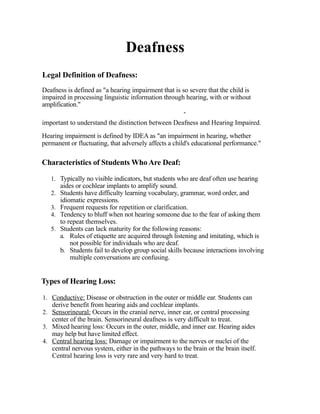
Deafness
- 1. Deafness Legal Definition of Deafness: Deafness is defined as "a hearing impairment that is so severe that the child is impaired in processing linguistic information through hearing, with or without amplification." - important to understand the distinction between Deafness and Hearing Impaired. Hearing impairment is defined by IDEA as "an impairment in hearing, whether permanent or fluctuating, that adversely affects a child's educational performance." Characteristics of Students Who Are Deaf: 1. Typically no visible indicators, but students who are deaf often use hearing aides or cochlear implants to amplify sound. 2. Students have difficulty learning vocabulary, grammar, word order, and idiomatic expressions. 3. Frequent requests for repetition or clarification. 4. Tendency to bluff when not hearing someone due to the fear of asking them to repeat themselves. 5. Students can lack maturity for the following reasons: a. Rules of etiquette are acquired through listening and imitating, which is not possible for individuals who are deaf. b. Students fail to develop group social skills because interactions involving multiple conversations are confusing. Types of Hearing Loss: 1. Conductive: Disease or obstruction in the outer or middle ear. Students can derive benefit from hearing aids and cochlear implants. 2. Sensorineural: Occurs in the cranial nerve, inner ear, or central processing center of the brain. Sensorineural deafness is very difficult to treat. 3. Mixed hearing loss: Occurs in the outer, middle, and inner ear. Hearing aides may help but have limited effect. 4. Central hearing loss: Damage or impairment to the nerves or nuclei of the central nervous system, either in the pathways to the brain or the brain itself. Central hearing loss is very rare and very hard to treat.
- 2. Suggested Learning Strategies: -Teacher Tips: 1. Reduce ambient noise in the classroom. 2. Face the class while presenting information. 3. Use appropriate body language, facial features, and signals while speaking. 4. Stand in one location, rather than moving around the room. Make sure the student is sitting near the teacher to facilitate lip-reading. 5. Use visual aids as often as possible. 6. Speak clearly, but do not exaggerate sounds while speaking. 7. Enroll in a sign language course, or at least learn some useful signs. 8. Create peer support 9. Help students learn to use their residual hearitig to the maximum extent possible. -Learning Tools: 1. Assigned services- including interpreters, note takers, teachers' aides or integration assistants. 2. Amplification devices for students with some residual hearing a. Hearing aids b. FM system (student has a small speaker, teacher uses a small ^ microphone) c. Cochlear implants (sophisticated electronic hearing device that transmit electric signals to the brain). 3. American Sign Language (ASL) 4. Manually Coded English (MCE) such as: Signed Exact English (SEE) 5. C-Print (a typist is present in class using standard abbreviation to capture what is being said. Students read information on a computer screen). 6. Teachers should include closed captioning when showing videos. Additional Resources: * Hands and Voices (non-profit): http://www.handsandvoices.org/ * National Dissemination Center For Children with Disabilities: http://nichcy.org/tags/deafness-or-hearing-impairment * National Association of the Deaf: http://www.nad.org/ * Utah Deaf Services: http://deafservices.utah.gov/ * Council for Exceptional Children: http://www.cec.sped.org/ * Bright Hub Education- http://www.brighthubeducation.com/ * American Society for Deaf Children: http://www.deafchildren.org/